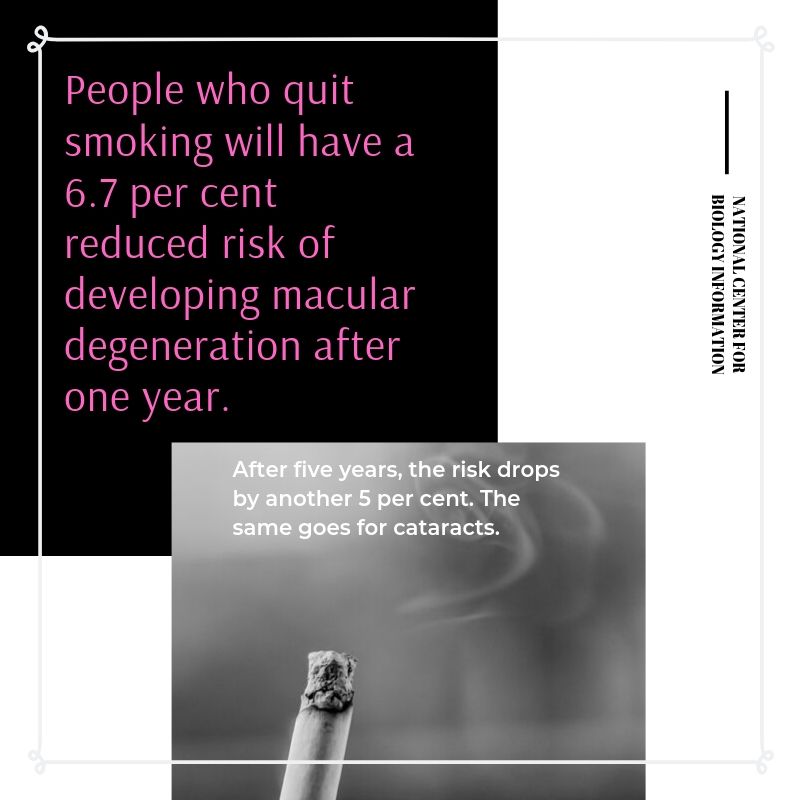
When you think of smoking-related diseases and conditions, lung cancer and emphysema are likely the first things that come to mind. But smoking can lead to a host of other diseases and conditions, including a shortened life span, weakened immune system, and greater risk of heart disease, diabetes, and stroke.
Did you also know that smoking can have a huge impact on your vision?
Smoking cigarettes can lead to a variety of eye-related conditions and diseases, some of which can result in total vision loss.
The following is a run-down of common vision-related diseases and conditions. Many of them develop as a natural sign of aging. However, if you’re a smoker, your likelihood of developing one of the issues mentioned below is far greater than if you were a non-smoker.
Cataracts
Casual to light smokers are two times as likely to develop cataracts than non-smokers. Heavy smokers who smoke more than 15 cigarettes a day are three times as likely to develop cataracts.
Cataracts are a clouding of the lens of the eye, making the ability to see difficult. Colors won’t look as bright and images that were once crisp and clear will appear cloudy or blurry. Cataracts are an extremely common eye condition, affecting over 24 million Americans over the age of 40, and while there is cataract surgery available that can remove cataracts, quitting smoking can decrease your chances of developing them.
Glaucoma
As already mentioned, smoking puts you at a greater risk of developing diabetes and having high blood pressure, the latter of which puts you at greater risk of heart disease. All these things, coupled with cataracts, increase your chances of developing glaucoma, a disease that causes the optic nerve to deteriorate.
The optic nerve is the nerve that sends information to the brain signaling your need to see. When that becomes damaged, as is the case with glaucoma, vision becomes limited, most often beginning with your peripheral vision.
The danger with glaucoma is most people do not even realize they have it until a large portion of the optic nerve has become damaged. Regular eye exams will help with early detection, but becoming a non-smoker will decrease your chances of ever even getting glaucoma.
Uveitis
Uveitis causes inflammation to the uvea, or the middle layer of the eye. Over time, it can cause damage to the retina and the iris, resulting in cataracts, retinal detachment, swelling of the retina, glaucoma, and total vision loss.
Smoking, in general, can cause inflammation within in the body. According to Dr. Nisha Acharya, an ophthalmologist and researcher for the University of California San Francisco, says in the article, Uveitis, iritis, and eye inflammation, this is due to the fact that smoke from cigarettes, “includes compounds that stimulate inflammation within the blood vessels.” The result is weakened immune function, which, in turn, is a leading factor in developing uveitis.

Graves’ eye disease
Graves’ eye disease is another issue that can arise as the result of inflammation. It can also develop if you are a smoker. It is also known as thyroid eye disease, because it affects the thyroid gland. The inflammatory response causes immune cells to target the thyroid. The thyroid then overproduces thyroid hormone. Symptoms of Graves’ eye disease include heart palpitations, weight and hair loss, fatigue, irritability, and eye problems.
In addition to the thyroid, Graves’ eye disease also targets the connective tissue and muscles around the eyes. The result is the eye muscles swell and cause the eyes to become red, swollen, or even take on a bulging appearance. When the muscles around the eyes become swollen, they also force the eye forward in the socket, which can hinder the eyes’ normal movement patterns, as well as give the appearance that you are always staring.
Dry eyes
Every time you blink, a coating of tears spreads over the eyes to keep the eyes moist and to protect them from damage and infection. When the tear film, as it is called, does not function properly, dry eyes can result. The eyes stop sufficiently producing tears, and the eyes can then become red, scratchy, and irritated.
Dry eyes commonly occur as a result of environmental factors like dry climates or environments, dust, wind, and smoke. Cigarette smoke, in particular, can break down the outer layer of tear film, which is the layer responsible for keeping the eyes lubricated, thus, leading to dry eyes.
One study, conducted by the departments of ophthalmology at Beni Suef University and El Nour Eye Hospital, both in Egypt, examined tear production in 250 smokers and 250 non-smokers. The study found that those who smoked produced far less tears than those who did not smoke. Those in the smoking group also experienced a higher rate of eye irritation, which also led to dry eyes, as well as increased the severity of their symptoms.
Quitting is key
According to the Centers for Disease Control (CDC), more people are addicted to cigarette smoking, and specifically nicotine, that any other drug, including alcohol and heroin. In fact, nicotine is believed to be even more addictive than alcohol and heroin.
Quitting smoking can literally add years onto your life by reducing your likelihood of getting heart disease, lung cancer, lung disease, and diabetes. Quitting smoking can also decrease your risk of developing eye-related diseases and conditions like cataracts, Graves’ eye disease, and glaucoma.
Because of cigarette incredibly addictive nature, quitting often involves a lot of stops and starts. That’s why it’s important to seek out treatment options like behavioral therapy, nicotine-replacement products, and working with your primary care physician will up your chances of quitting for good. Smokefree.gov is also another wonderful resource if you’re trying to kick the smoking habit.
Once you do quit, it’s important to see your eye doctor regularly, exercise regularly, maintain healthy blood pressure and cholesterol levels, and eat a diet full of foods that promote healthy vision like carrots, citrus fruits high in vitamin C, eggs, salmon, leafy greens and sweet potatoes.
It’s never too late to quit smoking. Why not make today the day you start improving your quality of life and the integrity of your eyesight?

